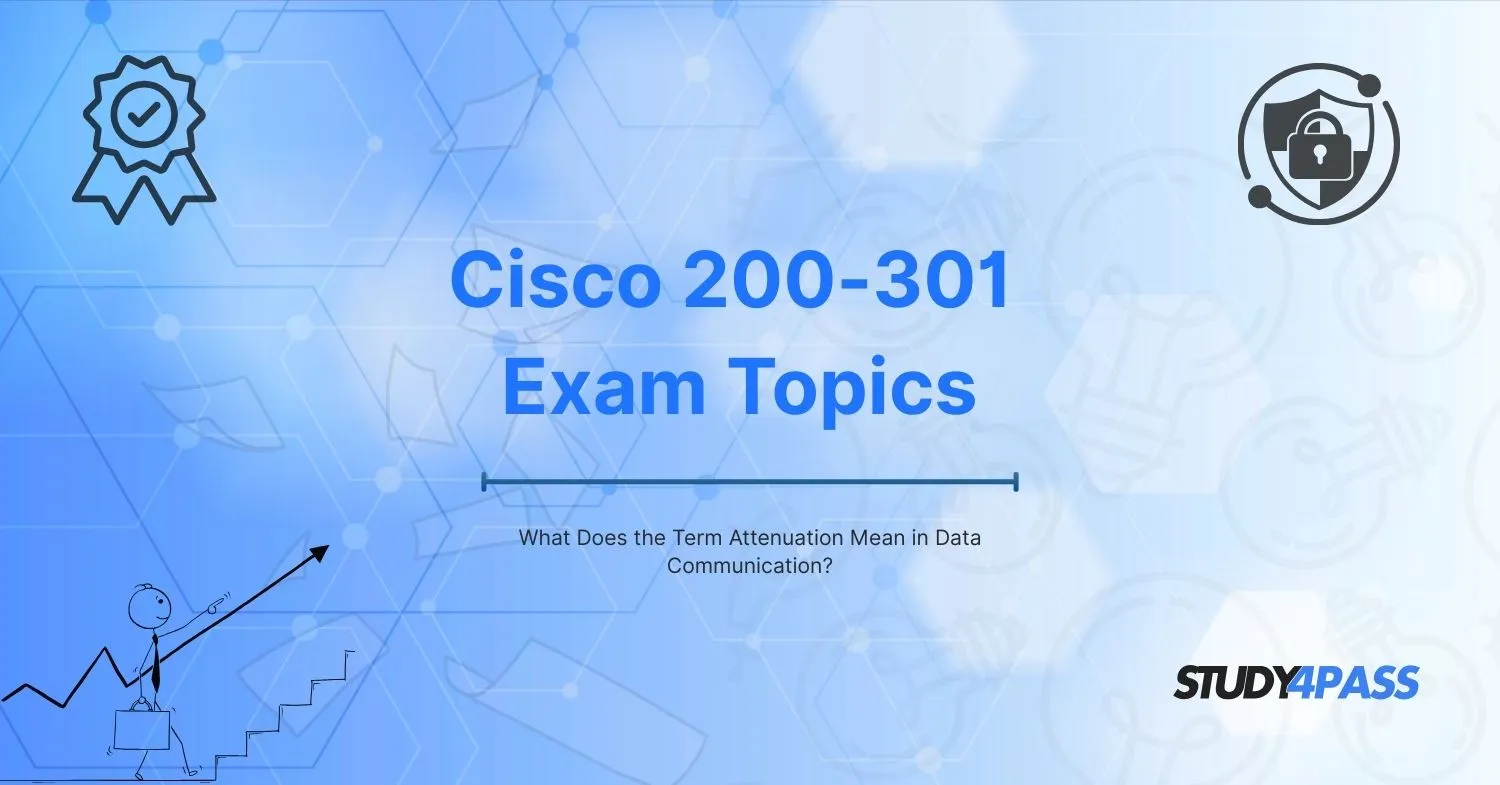Introduction To Cisco 200-301 Exam Topics
In the world of networking and data communication, understanding key concepts is essential for success, especially when preparing for exams like the Cisco 200-301 exam. One such fundamental concept is attenuation, a phenomenon that affects signal strength and data integrity.
If you're studying for the Cisco 200-301 exam, mastering topics like attenuation will help you grasp how data travels across networks and how to troubleshoot connectivity issues. In this blog, we’ll explore:
- The definition of attenuation
- Causes of attenuation in data communication
- Effects of attenuation on network performance
- How to measure and mitigate attenuation
Why this topic is relevant for the Cisco 200-301 exam topics
By the end of this guide, you’ll have a solid understanding of attenuation and its significance in networking essential knowledge for passing the CCNA 200-301 Exam Topics.
What Is Attenuation in Data Communication?
Attenuation refers to the loss of signal strength as it travels through a transmission medium, such as copper cables, fiber optics, or wireless channels. This degradation can lead to weaker signals, data corruption, and communication failures if not properly managed.
- Key Characteristics of Attenuation
- Measured in decibels (dB)
- Occurs in both wired and wireless transmissions
- Increases with distance and interference
- Affects analog and digital signals differently
Understanding attenuation is crucial for network engineers, as it impacts network design, performance, and troubleshooting key areas covered in the Cisco 200-301 exam topics.
Causes of Attenuation in Networking
Several factors contribute to signal attenuation in data communication. Recognizing these causes helps in designing efficient networks and troubleshooting connectivity issues—skills tested in the CCNA 200-301 exam.
1. Distance
The longer a signal travels, the more it weakens. This is particularly noticeable in:
- Copper cables (Ethernet): Resistance in wires dissipates energy as heat.
- Fiber optics: Although fiber has lower attenuation than copper, signals still degrade over long distances.
- Wireless signals: Radio waves lose strength as they propagate through air or obstacles.
2. Medium Resistance (Impedance)
- Different transmission media have varying levels of resistance:
- Copper cables suffer from higher attenuation due to electrical resistance.
- Fiber optic cables experience less attenuation because light signals face minimal resistance.
3. Interference (Noise)
External electromagnetic interference (EMI) or radio frequency interference (RFI) can distort signals, increasing attenuation. Common sources include:
- Power lines
- Wireless devices
- Heavy machinery
4. Connectors and Splices
Poor-quality connectors or improper splicing in cables can introduce signal loss. This is why proper cabling standards (like TIA/EIA-568) are emphasized in the Cisco 200-301 Certification.
5. Frequency and Bandwidth
Higher-frequency signals (e.g., in Wi-Fi or fiber optics) tend to attenuate faster than lower-frequency ones. Bandwidth limitations can also exacerbate attenuation effects.
Effects of Attenuation on Network Performance
Attenuation can severely impact network performance, leading to:
1. Reduced Data Transmission Speed
Weakened signals result in slower data rates, affecting applications like video streaming and VoIP.
2. Increased Errors and Data Loss
If a signal degrades too much, the receiving device may misinterpret data, leading to retransmissions and higher latency.
3. Limited Transmission Distance
Attenuation dictates the maximum cable length in Ethernet networks (e.g., 100 meters for Cat6) before requiring a repeater or switch.
4. Poor Wireless Connectivity
In Wi-Fi networks, attenuation from walls or interference can cause dead zones and weak signals.
Understanding these effects is vital for the Cisco 200-301 exam, as troubleshooting such issues is a key competency for network technicians.
Measuring Attenuation
Network engineers use tools like cable testers, OTDR (for fiber optics), and spectrum analyzers (for wireless) to measure attenuation. The formula for attenuation in decibels (dB) is:
text{Attenuation (dB)} = 10 log_{10} left( frac{P_{text{input}}}{P_{text{output}}} right)
How to Mitigate Attenuation in Networks
To minimize attenuation and maintain strong signal integrity, network professionals use several techniques—many of which are part of the Cisco 200-301 exam topics:
1. Using Signal Repeaters and Amplifiers
Repeaters regenerate signals in long cable runs, while amplifiers boost signal strength.
2. Choosing the Right Cable Type
Fiber optic cables (single-mode or multi-mode) have lower attenuation than copper.
Shielded twisted pair (STP) cables reduce EMI interference compared to unshielded (UTP) cables.
3. Proper Cable Management
Avoid sharp bends in fiber optics.
Use high-quality connectors and avoid excessive splices.
4. Adjusting Transmission Power
In wireless networks, increasing transmit power (within legal limits) can counteract attenuation.
5. Implementing Equalization Techniques
Digital signal processing (DSP) can compensate for attenuation in high-speed networks.
Why Attenuation Matters in the Cisco 200-301 Exam
The CCNA 200-301 exam tests your understanding of networking fundamentals, including:
- Network access (Ethernet, Wi-Fi)
- IP connectivity (routing, switching)
- Network troubleshooting (identifying signal loss issues)
- Since attenuation affects all these areas, you may encounter questions on:
- Maximum cable lengths (e.g., Ethernet standards)
- Troubleshooting weak signals
- Choosing the right medium (fiber vs. copper)
By mastering attenuation, you’ll be better prepared for both the exam and real-world networking scenarios.
Conclusion
Attenuation is a critical concept in data communication, directly impacting network performance and reliability. Whether you're dealing with copper cables, fiber optics, or wireless signals, understanding how signal loss occurs and how to mitigate it is essential for any network engineer.
Special Discount: Offer Valid For Limited Time “200-301 Exam”
Sample Questions for Cisco 200-301 Exam Prep Practice Tests
Actual exam question from Cisco's 200-301 Exam Prep Practice Test
Which of the following is a key function of the Address Resolution Protocol (ARP) in a network?
A) Translating IP addresses to domain names
B) Resolving IPv4 addresses to MAC addresses
C) Encrypting data packets for secure transmission
D) Assigning dynamic IP addresses to hosts


